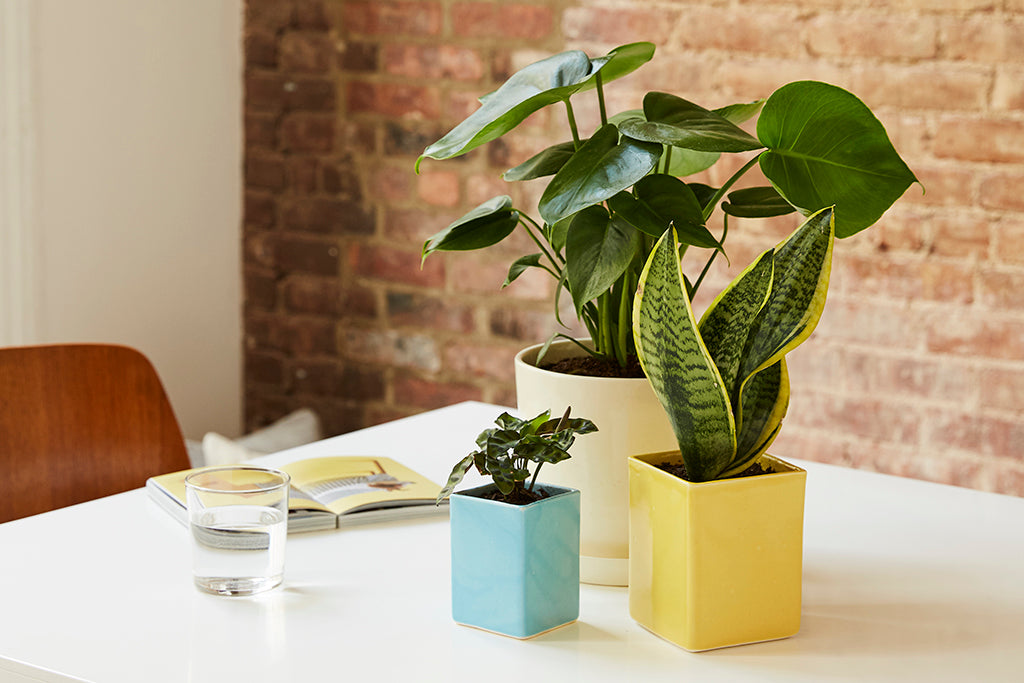
Common Care Questions
Just Say No: Leaf Shine
Because plants should look like plants. Not plastic. First things first: We do not recommend using leaf-shining products on your houseplants. Plants are already gorgeous. To help our plants look their best, here are a few better, safer ways to enhance your plants’ beauty without sacrificing your plants’ health.

Because plants should look like plants. Not plastic.
First things first: We do not recommend using leaf-shining products on your houseplants. EVER.
There are many commercial plant shine products are on the market and many retailers who use it to beautify their plants today. Not us! Leaf shining products are not beautifying, they’re bad! Plants breathe through their leaves through little pores called stomata and many leaf shine products end up clogging these stomata with either oil or wax. It’s just like your skin – you get blemishes when you have too much residue blocking your pores. The difference is, plants don’t get pimples. Their clogged pores mean suffocation and maybe even death.
The high shine look is not a good one. It’s very artificial and you may be inclined to forget that your plant is a living thing, not plastic decorum. Aside from looks, the upkeep is a headache. The oils and waxes from shine products end up sticking to dust in a clumpy way that au naturel leaves do not. Dust build up makes it more difficult to clean your plant and you’re in an endless cycle of cleaning and reshining.
Of course, plants are already gorgeous. To help our plants look their best, here are a few better, safer ways to enhance your plants’ beauty without sacrificing your plants’ health.
Damp cloth
This is an oldie, but a goodie. Wet your cloth (or sponge) and wring out any excess water. Support each leaf with one hand gently from under and wipe down, away from the stem very carefully with the other hand. Make sure you get to the undersides too, which is where pests usually like to hide. For delicate or very small leaves, try using a soft brush.
Shower
For all plants, but particularly for plants with delicate leaves that are difficult to wipe, showering is a great option. Remember to draw a lukewarm shower. Plants don’t like their water as warm as we do, but not cold either. Run your hands through the foliage and hold the plant at various angles to make sure that the shower hits the undersides of the leaves too. This method works great for ferns, orchids and palms. Just be wary that you don’t lose too much mix down the drain. Your plants need that and you don’t want clogged pipes.
Soap & water
Another foolproof method is to try a mixture of liquid dish detergent and water. There are two ways to do this: you can either dip a soft cloth in a soap/water solution and wipe the leaves carefully, or lather your hands with soap/water and gently apply it to the plant. Either way, be sure to clean both the top and bottom of the leaves, because it will also help to remove pests like spider mites. Be sure to thoroughly rinse the plant of all soap.
Vinegar or Lemon Juice & Water
Mixing vinegar with water is especially effective at getting rid of residue buildup on leaves. However, do not overdo it. This one is not meant to be part of routine plant maintenance, but instead only when needed. Start by mixing one teaspoon of vinegar with about a gallon of water. Then dip the cloth in your mix and apply to gently to your plants. An added bonus, the vinegar scent is great at repelling pests or your naughty pets. As an alternative to vinegar, you can use lemon juice, about ½ lemon squeezed per pint of water. Lemon juice and vinegar act as an acid and dissolve mineral salts. Unlike vinegar & water, lemon juice and water won’t rid you of pests, but it’s the trick for dissolving mineral deposits from hard water drying on your leaves.
Dusting feather
Use a dusting feather to gently sweep through your plants’ leaves. Obviously, this one will only work on larger, leafy plants. For example, a Monstera deliciosa, ZZ plant or Bird of Paradise. Make sure you get the undersides as well. We do not recommend this method with a fern, since you may disrupt its spores. Try using a soft makeup brush or paint brush for smaller, more delicate plants.
Takeaway
Keep in mind that it is imperative that you treat plants as carefully as possible when implementing any of the methods above. Steer clear of leaf-shine products, which will clog leaf pores. Keeping your plant’s leaves shiny and clean the natural way will also help to keep pests at bay. You can use this maintenance time to inspect the plant for damage, disease or any early signs of an unhappy plant.

Words By The Sill
Empowering all people to be plant people—a collection of articles from The Sill's team of plant experts across a variety of plant care topics to inspire confidence in the next generation of plant parents. Welcome to Plant Parenthood™.
Do Some Plant Shopping